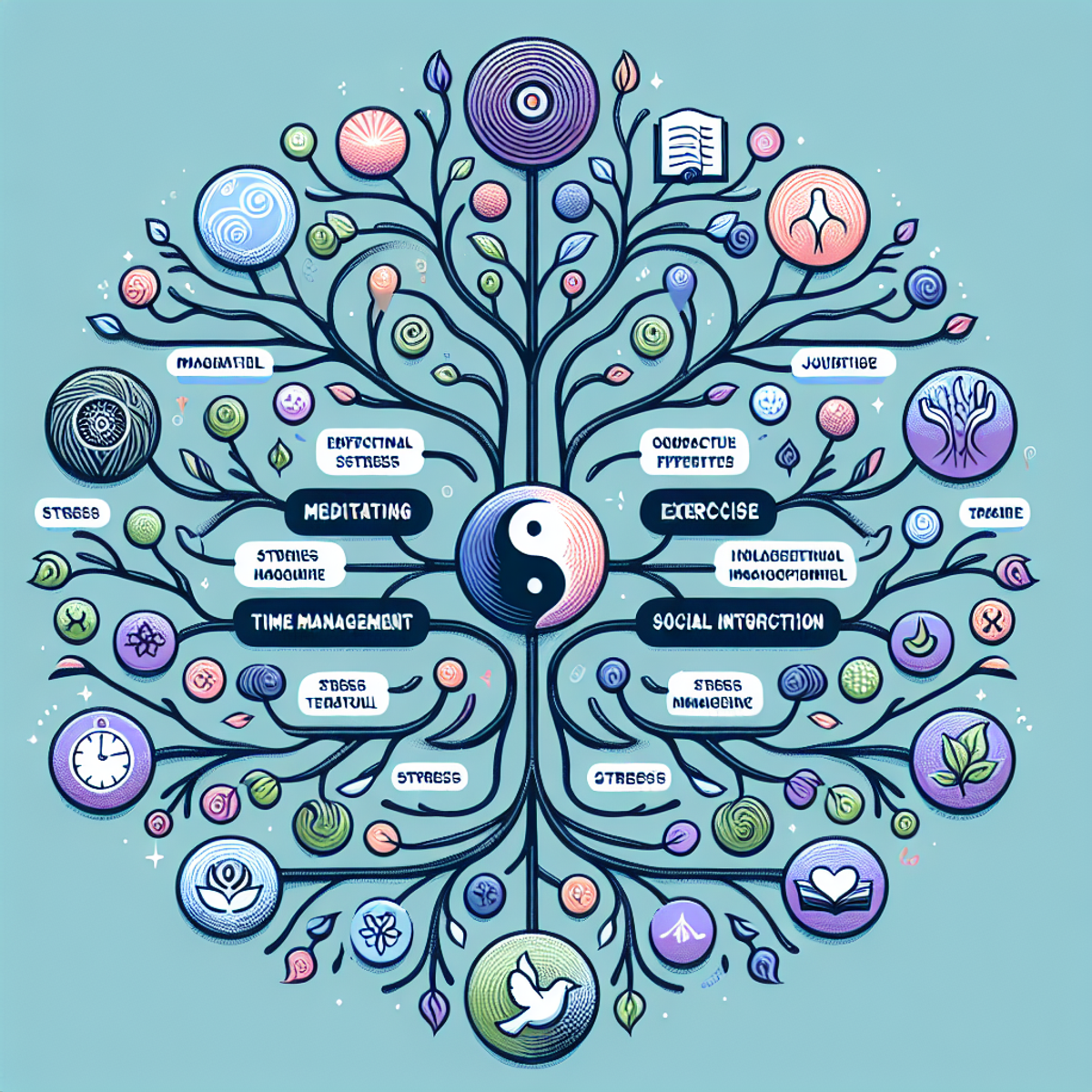Introduction
Welcome to a trip into the world of mind maps, a fun and handy tool that shows information in a picture. This ride involves your thoughts and ideas spreading out in all ways from a main point. It’s like having a guide for your thinking, leading you through the puzzle of your mind with clearness, focus, and order. Mind maps make solving problems easier, and help in making good choices. Here’s where a mind map for stress management can help Welcome to the new way of handling stress with mind maps, where being simple meets being useful.
The great thing about mind mapping is not only its simplicity but also how flexible it is. Whether it’s for learning new things, planning projects, making personal goals, or solving problems, mind maps can be your best friend.
Now, let’s go through this article together. We’ll start by figuring out what exactly a mind map is and how it helps with stress management. After that, we’ll learn how to make a good mind map to manage stress. We will then look at practical ways to use mind maps in different parts of life before chatting about tips to make these stress management tools even better. Ready? Let’s get started!
Understanding Mind Maps for Stress Management
A mind map for stress management is a simple visual way to help people sort out, arrange, and link thoughts around a main theme. Think of it as a tree with the main idea as the trunk, and branches showing related thoughts or smaller topics. Each branch can split into smaller branches or leaves, showing more specific ideas or actions.
Making a mind map means using lines, symbols, words, colors, and pictures to show your thoughts visually. This method helps with brainstorming and lets you freely explore ideas without feeling too much.
When making a mind map for managing stress, remember these important steps to make the process work better:
- Start with the main idea: This should be your main source of stress or worry. Write it in the middle of your paper or digital canvas.
- Branch out: Draw lines from this main idea to show major related thoughts or tasks causing stress. These are your main branches.
- Add details: From each branch, draw smaller branches to look into more detailed parts of that idea or task.
- Use pictures and colors: Use visuals and colors to make your mind map fun and easy to understand.
- Keep it changeable: A mind map is meant to be looked at again and changed as you get better at managing your stress.
Using these steps when creating a mind map can result in an effective tool for managing stress that deals specifically with your needs and problems.
How to Create an Effective Mind Map for Stress Management
Creating a mind map for stress management can be both healing and strategic. The beauty of mind mapping is its flexibility and personalization. Here’s a step-by-step guide to developing your mind map that can help you manage stress effectively.
Step 1: Start with a Central Idea
- Identify the Core: Begin by writing down the central idea or main concern that’s causing stress. This could be ‘Work Stress’, ‘Personal Goals’, or ‘Health Concerns’. Place this idea at the center of your page.
- Use an Image: For better recall and stimulation, represent your central idea with an image. Images can convey emotions and concepts quickly, which is helpful when revisiting your mind map later.
Step 2: Branch Out with Major Categories
- Draw Branches: From the central image, draw lines outwards towards the edge of the page. These will become branches that represent different categories or areas related to your central idea.
- Label Each Branch: Assign a clear label to each branch. If your central idea is ‘Work Stress’, labels might include ‘Deadlines’, ‘Team Communication’, ‘Skill Development’, etc.
Step 3: Explore Subcategories
- Add Layers: For each major category, consider subcategories and add them as smaller branches stemming from the main ones.
- Be Detailed: Include as many layers as needed to break down complex ideas into manageable chunks. Under ‘Deadlines’, you might have ‘Upcoming Projects’, ‘Time Management’, or ‘Delegation’.
Step 4: Connect Ideas
- Link-Related Concepts: Use lines to connect related subtopics across different branches. This helps in recognizing patterns and how different stressors may be interconnected.
- Visual Clues: Consider using colors, symbols, or lines of varying thickness to denote connections or underline certain areas.
Step 5: Personalize Your Map
- Choose Your Style: Whether you prefer neatness and structure or a more free-flowing approach, make sure your mind map resonates with your way of thinking.
- Keywords Over Sentences: Use single words or short phrases instead of long sentences to keep the mind map easy to navigate.
Step 6: Add Solutions and Strategies
- Brainstorm Solutions: In spaces where you see problems or stressors, brainstorm potential solutions or coping strategies. Write these next to the relevant branches.
- Action Steps: Convert these solutions into action steps you can take. These could look like reminders such as ‘Schedule Breaks’ or tasks like ‘Discuss Workload with Manager’.
Step 7: Review and Refine
- Assess Regularly: Revisit your mind map regularly to add new insights or adjust it as situations change.
- Keep It Dynamic: Your mind map should be a living document that grows and develops with you as you find new ways to manage stress.
Utilize Tools
If drawing isn’t quite your style or if you’d like to keep your mind maps digital:
- Software Options: There are many mind mapping tools online like XMind, MindMeister, or Bubbl.us that offer various features for creating digital mind maps.
- Templates Available: You might also find pre-made templates that can serve as starting points for your stress management mind map.
By following this guide, you’ll create a mind map for stress management that not only helps in picturing various aspects of stress but also serves as a roadmap for addressing them. Remember, the key is consistency; work on it bit by bit, and soon you’ll have a powerful tool in your hands for tackling everyday stressors.
Remember to give yourself permission to be creative and adapt the process to fit your needs—there is no right or wrong way to create a mind map. The goal is personal understanding and clarity, which leads to effective stress management and improved well-being.
.png?token=eyJhbGciOiJIUzI1NiIsInR5cCI6IkpXVCJ9.eyJ1cmwiOiJ1c2VyLWdlbmVyYXRlZC1pbWFnZXMvYWMxNDI2NzUtNTkxOC00ZGYwLTk4YWYtMTcwYzVmMzRlZjUxL2p1bmlhLWFydC1waG90byAoMikucG5nIiwiaWF0IjoxNzA2MDA2MDIyLCJleHAiOjIwMjEzNjYwMjJ9.2nHDOVxs_cgwMcsAnG71fuyJtpqLY9cd18TeiGmagpI)
Practical Ways to Use Mind Maps for Different Areas of Life
When it comes to managing stress, mind maps can be a priceless tool across many parts of life. By visually organizing thoughts and tasks, they help clarify the noise in our heads and bring a sense of order to our daily chaos. Here are some specific areas where a mind map for stress management can make a significant impact:
Personal Goals and Aspirations
- Map out life goals: Create branches for different aspects such as career, education, health, or personal development. Attach smaller goals that lead up to the big ones.
- Visualize success: Add images or symbols that represent what success looks like for you. It can serve as motivation when you’re feeling down.
Learning and Education
- Organize study materials: Break down complex subjects into digestible chunks. Use colors and icons to differentiate topics.
- Plan your academic year: Include deadlines, exam dates, and assignment milestones so you can prepare in advance and avoid last-minute stress.
Work Projects and Professional Development
- Project planning: Outline the steps needed to complete a project. Assign tasks to team members with due dates.
- Skill enhancement: Identify areas for professional growth. Add resources or courses that can help you learn new skills.
Daily Life and Time Management
- Daily to-do lists: Make your tasks important with a mind map. Put them together by need or connection.
- Meal planning: Create a weekly menu with grocery lists attached to each day, making shopping more efficient and reducing decision tiredness.
Relationships and Social Life
- Track important dates: Remember birthdays, anniversaries, or special events by including them in a faithful section.
- Resolve conflicts: Show the main reasons for a fight and possible answers in a picture form to start talks with clearness.
Health and Wellness
- Fitness plan: Schedule workouts and track progress towards fitness goals.
- Mental health tracker: Write down what makes you worried or tense and think of ways to deal with it.
Financial Planning
- Budgeting: Categorize expenses, set savings goals, and monitor progress monthly.
- Debt management: See your plan to lower debt with simple timeframes for when you want to be without debt.
Creative Projects
- Story plotting for writers: Map out characters, plotlines, and settings.
- Art project planning: Sketch ideas and list materials needed along with inspirational imagery.
Mind maps are useful in many situations because they help us arrange our thoughts. You can make a mind map on a piece of paper or a computer. The main point is to start with one idea and then add more ideas to it.
We can use pictures, colors, and links between ideas to make our mind maps. These maps are not just good for managing stress, but they can also spark new ideas. They let us see the whole picture while also focusing on the small details.
When life gets tough, these visual guides keep us focused. They remind us of our goals when we are stressed and confused by our daily tasks. Rather than feeling overwhelmed by a long list of things to do or worries, we can look at our mind map and tackle each task one at a time.
Remember, mind maps change as we do. Regularly update your mind map so it stays helpful and keeps stress away by making complex things clear.

Tips for Enhancing the Effectiveness of Your Stress Management Mind Maps
Optimizing the effectiveness of a mind map for stress management involves a blend of creativity, specificity, and consistency. Here are some tips to help you create more useful mind maps:
Be Visual
A significant advantage of mind mapping is its visual nature. Don’t hesitate to use colors, images, symbols, or even doodles. Making your mind map colorful stimulates your brain and can make the process more enjoyable.
Prioritize Simplicity
While it’s pleasing to include every single thought or idea, try to keep the mind map simple. Focus on the most critical points and avoid adding too much detail that could lead to confusion or mess.
Start with a Central Idea
The central thought is the heart of your mind map. Make sure it’s clear, straightforward, and relevant to your stress management goal.
Use Keywords
Instead of writing long sentences or paragraphs, use keywords or short phrases that encapsulate your ideas. This approach keeps your mind map uncluttered and easy to digest.
Maintain Consistency
Maintain consistency throughout your mind map. For example, if you’re using arrows to show connections in one area, use arrows all over for clarity.
Don’t forget, there’s no one-size-fits-all method when it comes to mind mapping. Discover what suits you best and modify these suggestions as required. The primary aim is to craft a tool that aids you in managing stress effectively.
Devoting time to create a mind map for stress management can be a game-changer. It’s akin to having a personal aide who assists in sifting through the mess of your thoughts and organizing them in a neat, manageable layout. By concentrating on the central issue and branching out into related sectors, you stimulate both halves of your brain, understanding your stressors and visualize solutions more lucidly.
Customize Your Mind Map For Stress Management
Keep in mind that this method is adjustable; you can change it to match your way or particular circumstances. Whether you’re using colors, pictures, or keywords, each addition to your mind map assists in simplifying the intricate parts of stress.
Beyond Stress Management
As you keep using mind maps, they may turn from a way to handle stress into a key way to shape your life. It’s not only about fixing problems—it’s about seeing a clearer way ahead in all parts of life, from work to personal targets.
Embrace the Power of Mind Maps
By making mind mapping a part of your daily habits, you’re giving yourself a strong helper. Keep trying new things and improving your method, and observe as those twisted worries start to loosen up. Ready to welcome the clearness and calm that comes with a tidy mind? Take some paper, get a pen, and start making a map for a more peaceful tomorrow.










